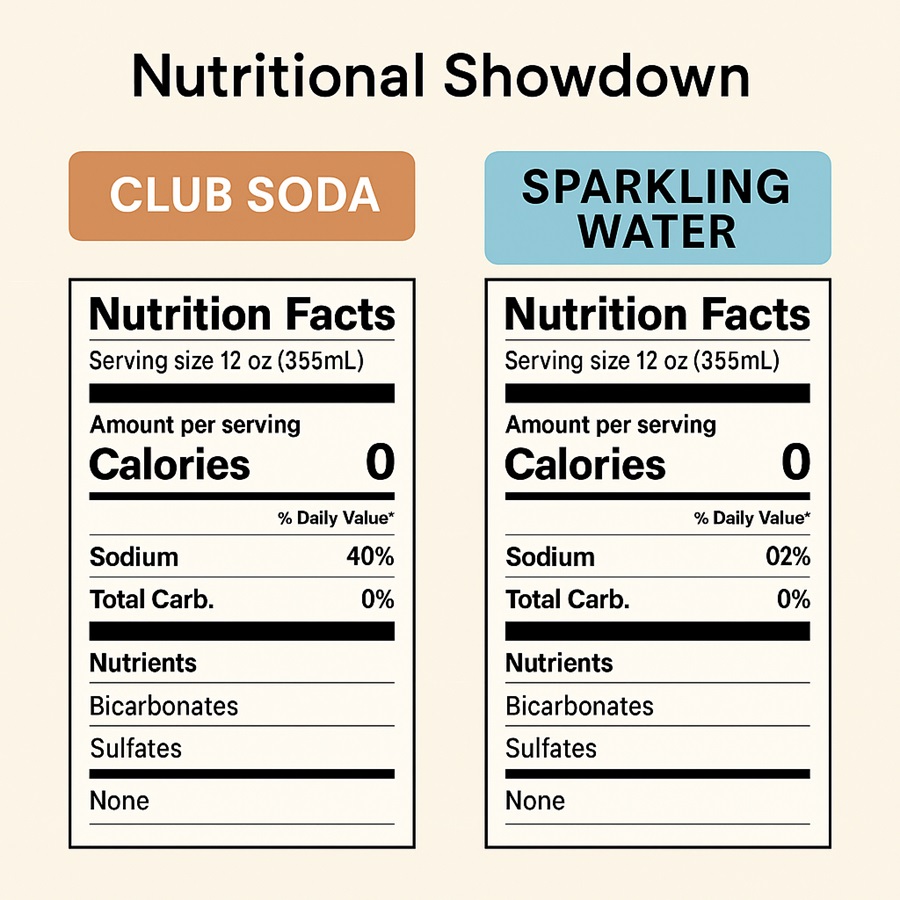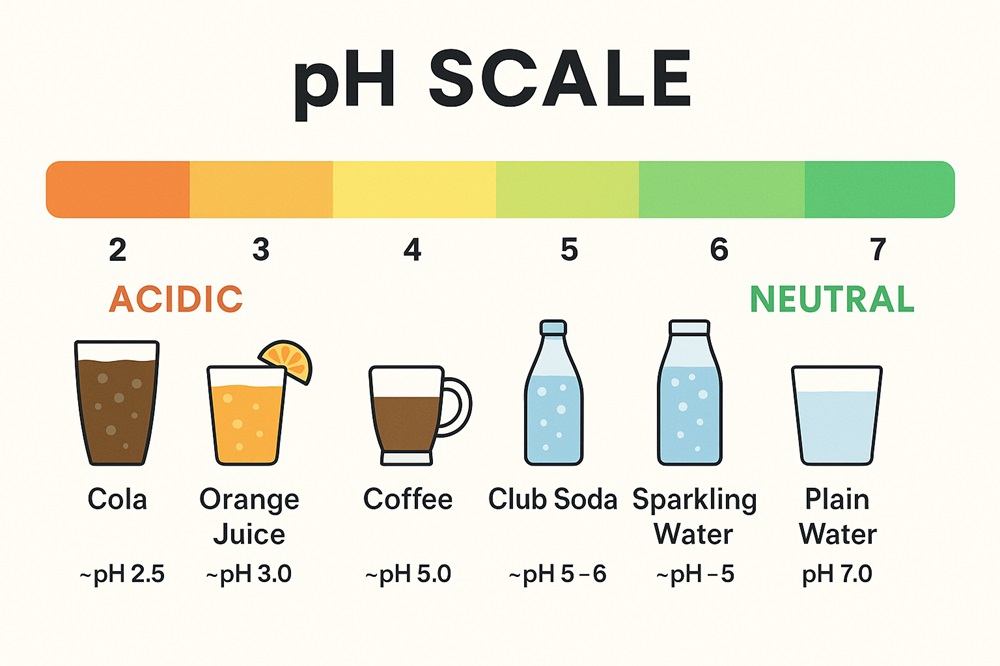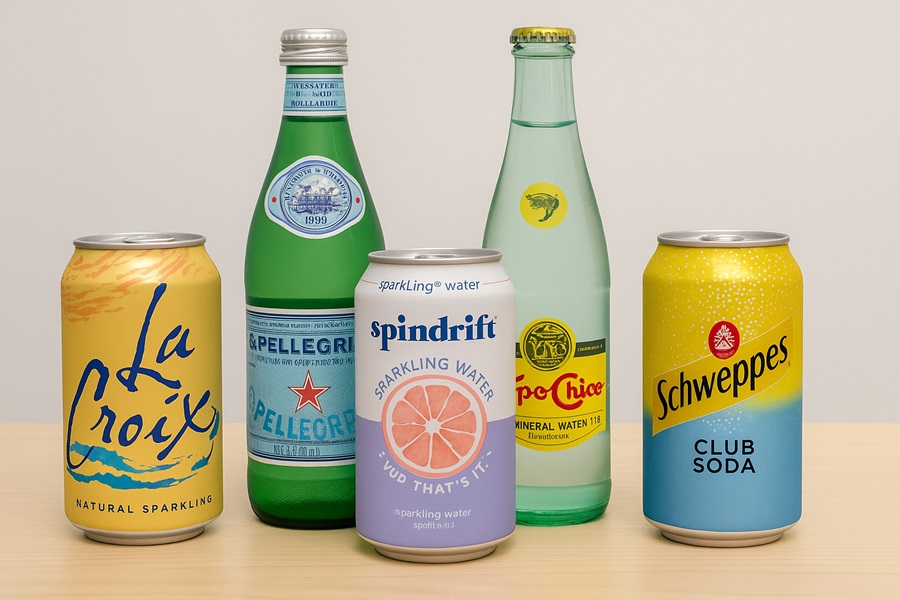Carbonated drinks are everywhere — from LaCroix at the office fridge to club soda behind the bar. They look the same, taste similar, and both fizz delightfully. But when it comes to health, many people find themselves wondering about the real differences: Club Soda vs Sparkling Water — are they truly the same, and which one is the healthier choice for daily drinking?
The short answer: sparkling water is generally healthier for daily hydration, while club soda has its place in cocktails and cooking. But to really understand why, let’s break it down step by step.
What They Really Are
Club Soda
Club soda is water that has been artificially carbonated and enhanced with added minerals such as sodium bicarbonate, potassium sulfate, or sodium chloride to alter taste.
- Artificially carbonated water (CO₂ added by manufacturers).
- Contains added minerals.
- Taste: slightly salty or mineral-like.
- Mostly used in cocktails, mixers, and baking.
Sparkling Water
Sparkling water is naturally or artificially carbonated water that contains no added minerals, although natural mineral varieties may include calcium, magnesium, and other trace elements.
- Either naturally carbonated (from springs like San Pellegrino) or infused with CO₂ without additives.
- May contain natural minerals, but nothing artificial.
- Taste: clean, crisp, sometimes subtly mineral.
- Best for everyday drinking as a soda alternative.
Key Difference: Club soda = added sodium/minerals. Sparkling water = natural (or plain).
Nutritional Showdown
| Nutrient | Club Soda (per 12 oz) | Sparkling Water (per 12 oz) |
| Calories | 0 | 0 |
| Sugar/Carbs | 0 | 0 |
| Sodium | 20–200 mg | 0–10 mg |
| Minerals | Added (bicarbonates, sulfates) | Natural (calcium, magnesium in mineral waters) |
| pH (Acidity) | ~5–6 | ~5 |
Both are calorie-free and sugar-free.
The real difference = sodium and additives in club soda.
pH Levels Explained: How Acidic Are They Really?
- What pH Means: pH measures acidity/alkalinity. Neutral is 7. Below 7 = acidic, above 7 = alkaline.
- Club Soda: pH ~5–6. Slightly acidic, but buffered by added minerals.
- Sparkling Water: pH ~4.5–5. Slightly more acidic, especially if citrus-flavored.
Comparison to Other Drinks:
- Cola → ~pH 2.5 (very acidic).
- Orange juice → ~pH 3.0.
- Coffee → ~pH 5.0.
- Plain water → ~pH 7.0 (neutral).
Key Takeaway: Both are mildly acidic but far less erosive than soda or juice. With good dental hygiene, risks are minimal.
Recomended Reading : What is the pH of distilled water?
Flavored Options: Club Soda vs Sparkling Water
Flavors are where things get tricky — and where health risks can sneak in.
| Drink | Flavor Options | Common Additives | Health Considerations |
| Sparkling Water | Widely available in fruity flavors (LaCroix, Bubly, Spindrift) | Natural flavors, citric acid, sometimes real fruit juice | Acidic flavors can erode enamel; most are sugar-free, but watch for artificial sweeteners. |
| Club Soda | Less common; some brands offer lemon-lime or berry versions, often marketed as mixers | Sodium, citric acid, sometimes added sugar | Higher sodium + acidity may increase bloating and affect blood pressure if consumed often. |
Health Risks at a Glance
- Dental Erosion: Flavored versions of both club soda and sparkling water are more erosive on tooth enamel than their plain counterparts, due to citric acid.
- Hidden Sweeteners: Some flavored club sodas contain added sugar, moving them closer to soft drinks than healthy hydration.
- Digestive Effects: Extra acidity can worsen bloating, heartburn, or reflux in sensitive individuals.
- Sodium Watch: Flavored club sodas still carry sodium — not ideal for kids, pregnancy, or people with high blood pressure.
Editorial Takeaway:
- For daily hydration, stick with plain sparkling water or lightly flavored versions without added sugar.
- Use flavored club soda mainly for cocktails — not as an everyday water replacement.
Health Impacts: How They Affect Your Body
Hydration
- Both hydrate equally well as plain water.
- Myth busted: carbonation does not dehydrate you.
Teeth & Bones
- Sparkling water is mildly acidic, but far less harmful than soda.
- Studies show it’s ~100x less erosive than cola.
- Club soda’s sodium doesn’t damage teeth but high sodium diets can affect bone health.
Digestion & Gut
- Sparkling water may ease constipation and indigestion.
- Club soda has long been used for mild indigestion relief.
- Downsides: can cause bloating or gas for sensitive people.
Heart & Kidneys
- Club soda’s sodium can be a concern for hypertension or kidney issues.
- Sparkling mineral water may improve heart health due to natural magnesium/calcium.
Club Soda vs Sparkling Water for Kids & Pregnancy: Safety Considerations
For Kids
- Plain water and milk are best for everyday hydration.
- Sparkling Water: Safe occasionally for older kids, but carbonation may cause gas. Flavored versions may increase enamel erosion risk.
- Club Soda: Added sodium offers no benefit and should be avoided as a daily drink.
Bottom line for kids: Water first. Sparkling water okay occasionally, but skip club soda.
For Pregnancy
- Sparkling Water: Generally safe in moderation. The fizz can ease nausea or morning sickness. Choose unsweetened, additive-free versions.
- Club Soda: Also safe occasionally, but sodium can worsen water retention or high blood pressure.
Bottom line for pregnancy: Sparkling water is the better daily choice. Club soda should be limited.
Everyday Uses: Where Each Works Best
- Club Soda: Cocktails, baking, and occasional digestion aid.
- Sparkling Water: Daily hydration, soda replacement, weight management.
Stat: 1 in 3 Americans now replaces soda with sparkling water weekly (Statista, 2023).
Label Decoder, Price, and Best Picks
How to Read Labels
- Club Soda: Always check sodium content (ranges 20–100+ mg).
- Sparkling Water: Look for “unsweetened” and “no artificial flavors.”
Pro Tip: If the label only says “carbonated water,” it’s sparkling water. If you see “sodium bicarbonate” or “potassium sulfate,” it’s club soda.
Price Comparison
- Club Soda: ~$0.50–$0.70 per liter, cheapest option.
- Sparkling Water: $1–$2 per can; imported mineral waters $2.50–$3 per liter.
Best Picks
- Club Soda: Schweppes, Canada Dry.
- Sparkling Water: LaCroix, Topo Chico, Spindrift, San Pellegrino, Perrier.
Club Soda vs Sparkling Water vs Tonic Water
| Drink | What It Is | Sugar Content | Additives | Taste Profile | Best Uses |
| Club Soda | Carbonated water with added minerals like sodium bicarbonate or potassium sulfate | 0 g | Sodium + minerals | Slightly salty, mineral-like | Cocktails, baking, occasional digestion aid |
| Sparkling Water | Naturally or artificially carbonated water, sometimes with natural minerals | 0 g | None (unless flavored) | Clean, crisp, sometimes subtly mineral | Everyday hydration, soda replacement |
| Tonic Water | Carbonated water with quinine and added sugar/sweeteners | 8–10 g sugar (per 8 oz) | Quinine + sweeteners | Sweet, bitter finish | Gin & tonic, cocktails only |
Quick Check:
- If it tastes sweet → it’s tonic water.
- If it tastes salty → it’s club soda.
- If it tastes clean and crisp → it’s sparkling water.
Myths & Misconceptions
- ❌ “Carbonated water dehydrates you.” → False.
- ❌ “Sparkling water is as bad for teeth as soda.” → False.
- ❌ “Club soda is unhealthy.” → False. Sodium is the main concern.
Environmental Impact: Bottled vs Canned vs Home Carbonation
Beyond health, there’s an eco-story behind every sip of fizzy water.
- Bottled Imports: Premium brands like San Pellegrino or Perrier travel thousands of miles, leaving a higher carbon footprint.
- Plastic vs Aluminum: Aluminum cans are easier to recycle than single-use plastic bottles, making them a greener choice.
- Home Carbonation: Devices like SodaStream cut down drastically on packaging waste, allowing you to carbonate tap water at home.
Editorial Take: Sparkling water may be healthier than soda for your body, but the packaging choice determines how healthy it is for the planet.
Eco Tip: For everyday hydration, a SodaStream or local seltzer in recyclable cans is the most sustainable pick. Save imported mineral waters for special occasions.
Buyer’s Guide: Best Picks for Every Need
The fizzy aisle can feel overwhelming. Here’s a quick guide to choosing the right bubbles:
| Category | Best Pick | Why It Wins |
| Best Everyday Sparkling Water | LaCroix | Affordable, wide flavor range, zero calories and sodium. |
| Best Premium Mineral Water | San Pellegrino | Naturally rich in minerals, smooth fizz, European classic. |
| Best for Cocktails (Club Soda) | Schweppes Club Soda | Crisp taste, consistent bubbles, perfect mixer. |
| Best Natural Flavor | Spindrift | Uses real fruit juice, cleaner label than most flavored waters. |
| Best Fitness-Friendly Choice | Topo Chico Mineral Water | High carbonation, contains natural magnesium/calcium, refreshing post-workout. |
Pro Tip: Always check the label. If sodium is listed above 100 mg per serving, save it for cocktails rather than daily sipping.
Club Soda vs Sparkling Water How Much Is Too Much?
Sparkling Water
- Dental Health: Plain sparkling water can be enjoyed daily. Limit flavored versions (with citric acid) to 1–2 cans a day to reduce enamel wear.
- Digestive Sensitivity: Most people tolerate it well, but if you’re prone to bloating, reflux, or IBS, keep it to 2–3 servings per day.
- Hydration: Sparkling water hydrates as well as still water, but experts recommend balancing with plain water to protect teeth and digestion.
Safe Range: 1–3 cans (12 oz each) daily is fine for most people.
Club Soda
- Sodium Content: Depending on the brand, a single 12 oz serving may contain 20–200 mg of sodium. Regularly drinking multiple cans can contribute significantly to your daily intake, especially if you already consume salty foods.
- Health Concerns: People with high blood pressure, kidney disease, or heart concerns should be more cautious.
- Everyday Use: Best reserved for cocktails, mixers, or occasional baking rather than daily hydration.
Safe Range: Up to 1 can per day for most healthy adults, but avoid making it your primary water source.
Key Takeaways: Club Soda vs Sparkling Water
| Factor | Sparkling Water | Club Soda |
| Everyday Use | Best for daily hydration, soda replacement | Best for cocktails, mixers, and occasional baking |
| Nutrients | Zero calories, little/no sodium, may contain natural minerals | Zero calories, but added sodium and minerals |
| Flavored Options | Widely available, usually sugar-free, but acidity may erode enamel | Less common, some versions contain added sugar and sodium |
| Health Risks | Mild enamel erosion risk (especially flavored), possible bloating for sensitive stomachs | Added sodium can affect blood pressure; flavored versions may add sugar |
| Best For | People seeking a healthy soda alternative | Cocktail lovers and bakers |
| Avoid If | You have frequent dental erosion concerns (choose plain versions) | You have hypertension, kidney disease, or follow a low-sodium diet |
Bottom Line:
- Sparkling water → the healthier daily choice.
- Club soda → safe in moderation, but best saved for cocktails or recipes.
Expert & Real-World Perspectives
- Dietitian Insight: Shelley Case, RD — “For those watching sodium, sparkling water is a better daily option.”
- Case Studies:
- Hypertensive patient lowered sodium intake by switching from club soda to sparkling water.
- Athlete uses magnesium-rich sparkling water as a natural electrolyte.
The Verdict: Which One Is Healthier?
- Daily hydration → Sparkling water wins.
- Cocktails/baking → Club soda shines.
- For hypertension/kidney concerns → Avoid excess club soda.
Bottom line: Both are healthier than soda, but sparkling water is the safer everyday choice.
FAQs
Q: Is Perrier club soda or sparkling water? → Sparkling mineral water.
Q: Can I drink club soda every day? → Yes, but not if you’re sodium-sensitive.
Q: Does carbonation weaken bones? → No, only sugary sodas show that link.
Q: Which is better for weight loss? → Sparkling water.
Conclusion
Both club soda and sparkling water are healthier than sugary sodas, but they serve different roles. For daily hydration, sparkling water is the smarter pick. For cocktails or baking, club soda works best.
Best advice: Read the label, watch sodium, and enjoy your bubbles without guilt.





